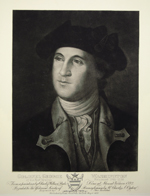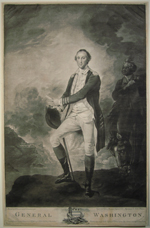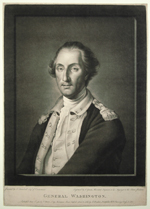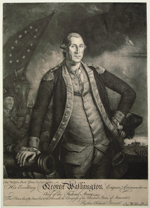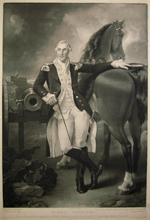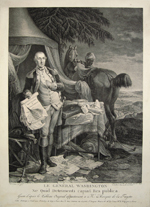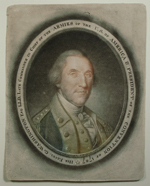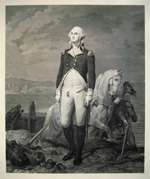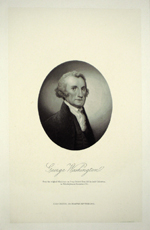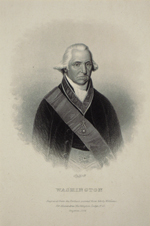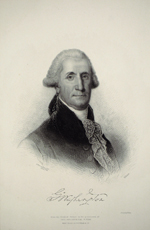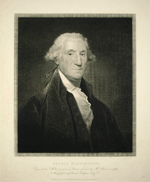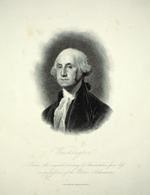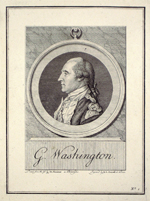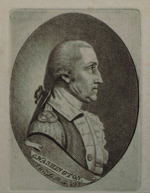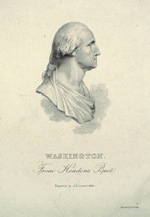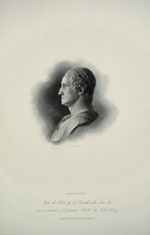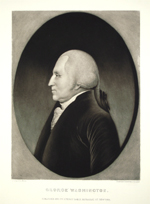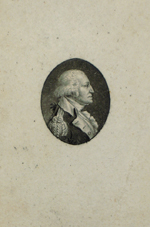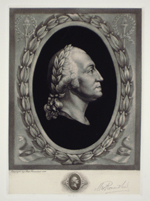|
Section I Selections from the C.W. McAlpin Collection
Section I Selections from the C. W. McAlpin CollectionSection IWashington’s Physical Appearance in Portraits Although Washington’s face is probably the most recognizable one in the history of this country, there is a certain incongruity among his portraits that leads one to wonder about his true appearance. Washington disliked sitting for portraits, but he agreed to do so for approximately two dozen artists, and for some of them on multiple occasions. Many of these life portraits are reproduced here. Because these prints are at least once removed from the original painting, drawing, or sculpture, and more often than not were executed by an artist other than the one responsible for the life portrait, they cannot provide a truly accurate record of Washington’s features. However, they do offer an interesting study of the components of Washington’s physique, and the printmakers’ own partialities. They reflect both how the artists perceived his appearance and personality, and how they wanted to project his image and status. They also trace, to some extent, the experiences Washington endured during the last quarter-century of his life, and the physical and emotional consequences of those years.
Charles Willson Peale first painted Washington from life in 1772, at Mount Vernon, for a portrait commissioned by Martha Washington to accompany an existing portrait of herself by another artist. Peale depicted Washington in the uniform he wore as lieutenant colonel of the Virginia militia in the French and Indian Wars. During his stay at Mount Vernon, Peale also painted another version of the portrait, of the head and shoulders only. He may have intended this smaller canvas to serve as a model for future portraits of Washington, but never used it because he had access to the general himself on six other occasions. The little painting remained unused in Peale’s studio for decades until someone—apparently one of his artist sons—filled in the torso with a Continental Army uniform. It is this painting that is rendered here in mezzotint. It is interesting to note the development of Washington’s facial features and character as portrayed by Peale over the course of 23 years.
John Trumbull served briefly in the Continental Army, from 1775 to 1777, primarily as an aide-de-camp to Washington. In 1780 Trumbull traveled to England in hopes of apprenticing to a professional painter, but his stay there was relatively short, and he managed to produce just one significant work during that time, a full-length portrait of Washington from memory, perhaps aided by a copy of a portrait by Peale. Trumbull’s portrait, depicting an impressive, confident general standing on the banks of the Hudson River, was soon engraved in London by Valentine Green, and became one of the first representations of Washington (together with the profile by Prévost after Du Simitière, also shown here) to reach an extensive European audience. Consequently, Green’s print was a source for numerous European portrayals of Washington, including the two printed cottons exhibited here.
Perhaps the success of his full-length mezzotint of Washington after Trumbull encouraged Green to issue a new, bust-length version. Trumbull’s painting does not afford much facial detail, so it is likely that Green was guided by a Peale portrait or by Trumbull’s own description of the general, or both. While the face overall may not resemble Washington’s very closely, the scar on his left cheek reflects some degree of accuracy. Washington did indeed have scarring on that cheek, the result of a fistula caused by an abscessed tooth. Peale’s 1779 painting of Washington, reproduced in the following mezzotint, also depicts that scar (though it appears on the right cheek in the print, since it is a mirror image of the painting), and therefore likely served as a reference for Green. This print reveals a concern for veracity not common in European prints of Washington by that time.
Peale based this print on his 1779 full-length painting of Washington, commissioned by the Supreme Executive Council of Pennsylvania. The painting was so popular that it prompted a great demand for replicas, and Peale judged it well worth his while to reproduce it in mezzotint. All of Peale’s skillfully rendered engravings of Washington were based on his own paintings, with the result that the prints themselves can almost be considered life portraits. This image depicts Washington in his role as commander in chief of the Continental Army. In the distance stands Nassau Hall, the main building of the College of New Jersey (now Princeton University). During the Revolution, Nassau Hall was occupied as barracks, first by the British and later by the Americans. In January 1777 Washington and his troops defeated the British in the Battle of Princeton.
In 1783 Peale sent to London a painting of Washington, probably based on his portrait of 1779 (see the previous print). The painting was purchased by the publisher Joseph Browne, who commissioned a mezzotint copy of it from Valentine Green, whose recent prints (also on view here) after Trumbull’s 1780 portrait had met with success. Browne also hired the artist Thomas Stothard to prepare a drawing of the painting, on a smaller scale, to facilitate Green’s translation of the painting to print. In the process, Stothard deviated significantly from the original, extending Washington’s figure to full length, altering his pose and figure, adding a horse, and turning the cannon to face the viewer. Gone are the soldier and the flag with thirteen stars. The result is an inaccurate but pleasing portrayal of a stylish, affable general and his trustworthy horse, an attractive image that would run little risk of offending British patrons.
The first of Peale’s representations of Washington to arrive in Europe was probably a painted copy of the portrait he had done for Hancock in 1776 (which is reproduced in Joseph Hiller’s mezzotint, also on view here). The replica is known to have been in the possession of the marquis de Lafayette, who had much admired the original. Lafayette arrived in America in 1777 explicitly to join Washington’s army, but returned temporarily to France in 1779–80 to secure financial aid for the Revolution, perhaps taking the replica with him. In his design for the print, Le Paon retained the basic pose of Peale’s Washington, but elaborated a good deal on the setting and props, adding a military tent, horse and attendant, a military camp in the background, and numerous documents relating to the Revolution, including the Declaration of Independence and the Treaty of Alliance with France in Washington’s right hand, and the torn papers on the ground concerning Britain’s attempts at reconciliation with the colonies. Le Paon and Le Mire also produced a companion portrait of Lafayette dressed in the uniform of the Continental Army.
In 1787 Peale undertook to create a series of printed portraits of Revolutionary War figures. After completing the first three, of Benjamin Franklin, the marquis de Lafayette, and Reverend Joseph Pilmore, he wrote to Washington asking him to sit for another portrait. Washington, recently elected president of the Constitutional Convention, obliged, and by September the resulting mezzotint was complete. However, disappointing sales led Peale to abandon the ambitious series, and he ceased making engravings altogether. But before doing so, he experimented with inking the plate with several colors at once. The resulting print is probably one of the earliest examples of a multicolor engraving in America. As Peale’s only reference to his activity in color printing appears in a diary entry in July 1788, this impression was probably printed at that time.
In his Recollections and Private Memoirs of Washington, Washington’s adopted son, George Washington Parke Custis, wrote that Washington’s “matchless limbs have in but two instances been faithfully portrayed—in the equestrian portrait by Trumbull, of 1790, a copy of which is in the city hall of New York, and in an engraving by Loisier [i.e., Laugier], from a painting by Cogniet, French artists of distinguished merit. The latter is not an original painting, the head being from Stuart, but the delineation of the limbs is the most perfect extant.” On the subject of Washington’s appointment as commander of the Continental Army, John Adams joked that Washington was always singled out as a leader because he was invariably the tallest man present (he was six feet, two inches tall). Although this clearly was not the basis for Congress’s selection, one cannot ignore the fact that, as the American physician and Revolutionary Benjamin Rush declared, “He has so much martial dignity in his deportment that you would distinguish him to be a general and a soldier from among ten thousand people.” This print more than any other on exhibit here conveys the impressive physical presence of the commander in chief. .
Archibald Robertson moved to the United States in 1791, bringing with him a gift for Washington—a small wooden box made from the tree reputed to have sheltered William Wallace (1272?–1305), the Scottish national hero renowned for leading battles against the English—from David Stewart Erskine, 11th Earl of Buchan, an avid supporter of Washington who considered him “the modern American Wallace.” Erskine desired a portrait of the American president to add to his extensive “collection of portraits of the most celebrated worthies in liberal principles and in useful literature.” Robertson started out by creating miniatures from life of George and Martha in watercolor on ivory. These he kept for himself, and he eventually completed the larger painting in oil for Erskine in 1793. This print is based on the miniature.
In 1793 William Joseph Williams appealed to the Alexandria Masonic Lodge No. 22, of which Washington had been Master from 1788 to 1789, offering a portrait of Washington in exchange for a formal letter that would give him access to the president. The lodge agreed, and Williams achieved the desired sitting. The resulting pastel drawing is the only official Masonic portrait of Washington executed during his lifetime. Further information on Washington’s membership in the fraternity is provided in the label that accompanies the lithograph Washington as a Mason, also on display here. Of greater interest in this portrait is the portrayal of Washington as is, blemishes and all, rather than as an idealized heroic icon. Indeed, Williams had been instructed by the lodge members, who knew Washington as a private individual, to render a faithful likeness of their acquaintance. The result is a simple, candid record of a face marked by smallpox scars and a mole, and by the exhaustion of years at war and subsequently as president of the newly formed republic. The few references to his former status as lodge master are the ornament hanging from his neck and the apron and sash. Although Williams’s drawing was not intended for a wide audience, it was eventually much reproduced and distributed.
Conflicting opinions exist as to whether or not Wertmüller painted Washington from life, and as to the accuracy of his portrait. According to Wertmüller’s own records, he painted Washington in August 1794 “in the Senate chamber where the Congress assembles at Philadelphia.” George Washington Parke Custis wrote that “Of the painting said to be an original, by Wertmuller, and executed about 1795, we literally know nothing; yet, in 1795, we were not absent from the presidential mansion in Philadelphia a single day….” Presumably, however, Wertmüller’s execution of it in the Senate, and not at Washington’s residence, might explain Custis’s ignorance of the matter. The artist Rembrandt Peale, a son of Charles Willson Peale and a painter himself of a life portrait of the president, considered Wertmüller’s representation “a highly finished laborious performance” with “a German Aspect.” While it certainly contrasts with the contemporary trends and developments of American portraiture, led by Gilbert Stuart, Wertmüller’s depiction provides us with a new perspective on the infamously stoical president.
Stuart’s first portrait of Washington, painted in 1795, was commissioned by the Philadelphia merchant John Vaughan. Vaughan sent the portrait to his father, Samuel, in London, where it was subsequently engraved in 1796 for inclusion in volume 3 of the English edition of Johann Caspar Lavater’s Essays on Physiognomy, Designed to Promote the Knowledge and the Love of Mankind. Lavater, though undoubtedly influenced by his familiarity with Washington’s reputation, provided the following analysis: “Every thing in this face announces the good man, a man upright, of simple manners, sincere, firm, reflecting and generous.”
Probably the most-copied representation of Washington by Stuart is his “Athenaeum” portrait of 1796, best known through its reproduction on the dollar bill. Stuart recalled, “When I painted him, he had just had a set of false teeth inserted, which accounts for the constrained expression so noticeable about the mouth and lower part of the face.” Many portraits on view here are based on the “Athenaeum” head.
Du Simitière, a Swiss artist active in America, recorded on February 1, 1779, that Washington “at the request of the Hon Mr. Jay President of Congress, came with him to my house this morning & condescended with great good nature to Sit about ¾ of an hour for the above likeness having little time to Spare, being the last day of his stay in town.” Du Simitière made a series of profile portrait drawings of prominent figures of the Revolution, with the intention of having them engraved in Europe. Despite the risks of shipping portraits of this nature across the Atlantic in wartime, 14 of his drawings reached France, where they were engraved by Prévost. The prints were published in two sets and widely circulated in Europe, with the result that they were frequently copied in a variety of mediums, such as one of the printed textiles on view here.
Wright’s delicate and intimate profile of Washington was much copied by contemporary artists in a variety of media, especially prints and medals (see, for example, Amos Doolittle’s Display of the United States of America, also on exhibit here). There is a popular, though not necessarily truthful, story that Wright secretly sketched the president while he sat in his pew in Saint Paul’s Chapel in New York. Washington is known to have posed for Wright in 1783, for a painting and a sculpture, and it is conceivable that the artist drew upon that experience for this little print.
Houdon’s 1785 bust of Washington was part of the French sculptor’s preparation for a full-length statue commissioned by the Virginia legislature for the statehouse in Richmond. The sculptor was recommended by Franklin and Jefferson, ambassadors to France during the Revolution. Houdon stayed at Mount Vernon for two weeks, often following Washington around on his daily tasks in an effort to get to know him. During this time Houdon created the bust, in clay, as well as a plaster life mask. Before his departure Houdon presented the bust to Washington as a gift, but took with him the life mask to aid his work on the statue. Houdon’s portraits of Washington have been very influential on other artists’ renderings of Washington in all mediums.
In late 1791 or early 1792, and again in 1795, Washington sat for the Italian sculptor Giuseppe Ceracchi. This reproduction of Ceracchi’s marble bust shows an idealized portrait, a depiction of the president as a Roman emperor with a head of close-cropped curls and a toga draped over his shoulders. However, comparison with the profiles by Wright and Saint-Mémin, also in this exhibit, reveals that Ceracchi’s rendering of the face may indeed have been quite accurate.
In 1796 or 1797 the pastel portraitist James Sharples created three life portraits of Washington in Philadelphia, which were among the last portraits for which Washington would sit. In order to ensure physiognomic accuracy, Sharples is reported to have traced Washington’s profile with a mechanical instrument, likely similar to the tool employed by Saint-Mémin for his profile of the president, in the following print. George Washington Parke Custis described Sharples’s drawing as “an admirable likeness, the profile taken by an instrument, and critically correct.”
This tiny profile portrait of Washington was made to adorn a gold mourning ring, where it would have been set under glass. The engraving was based on a sketch created by Saint-Mémin in late 1798, believed to be the last portrait of Washington drawn from life. The artist used a mechanical drawing aid called a physiognotrace, made up of four mobile arms joined together to form a parallelogram. While the artist traced the sitter’s head with one end of the instrument, the other end, to which a pencil was attached, drew the profile in miniature on a piece of paper. A similar instrument was then used to copy the image onto a copper printing plate.
|

